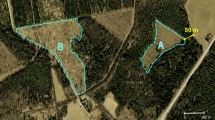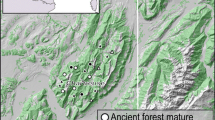Abstract
The extrapolation of metapopulation concepts to saproxylic insects suggests that the occupancy of forest patches and the colonization of ephemeral deadwood substrates are driven by micro-evolutionary processes that are related to adaptive plasticity and intraspecific sex-dependent polymorphism of dispersal traits. We hypothesized that forest fragmentation could favor more mobile individuals within populations, but little empirical data have been published on the potentially sex-biased response of insect populations to habitat availability. We selected 88 fragmented woodlots in two European agricultural landscapes to cover different degrees of spatio-temporal fragmentation, from small, isolated and recently established woodlots to large, inter-connected ancient woodlots. In line with our hypothesis, the average wing loading (WL), used as a proxy for dispersal ability, for each of nine flight-dispersing saproxylic beetle species should be lower in recent, small, isolated woodlots than in ancient, large, inter-connected woodlots, respectively (i.e. ancient vs. recent, small vs. large, isolated vs. connected). Forest patch size did not significantly influence the average dispersal ability of beetle colonizers. However, WL of one-third of the tested species did significantly respond to forest ancientness or connectivity. Significant patterns were sex-biased, probably due to the contrasting role of males and females in species colonization dynamics. WL was lower in recent than in ancient forest plots for Melandrya barbata males, and it was lower in isolated than in connected woodlots for Tetratoma ancora and Phymatodes testaceus males. Contrary to expectations, we did not observe any decrease in polymorphism of dispersal abilities with decreasing woodlot size or increasing isolation. Our findings give support to the usefulness of gender consideration in insect conservation ecology studies.

Similar content being viewed by others
References
Alexander DE (2002) Nature’s flyers: birds, insects, and the biomechanics of flight. Johns Hopkins University Press, Baltimore
Arribas P, Velasco J, Abellán P, Sánchez-Fernández D, Andújar C, Calosi P, Millán A, Ribera I, Bilton DT (2012) Dispersal ability rather than ecological tolerance drives differences in range size between lentic and lotic water beetles (Coleoptera: Hydrophilidae). J Biogeogr 39(5):984–994
Beaudoin-Ollivier L, Bonaccorso F, Aloysius M, Kasiki M (2003) Flight movement of Scapanes australis australis (Boisduval) (Coleoptera: Scarabaeidae: Dynastinae) in Papua New Guinea: a radiotelemetry study. Aust J Entomol 42(4):367–372
Berwaerts K, Dyck HV, Aerts P (2002) Does flight morphology relate to flight performance? an experimental test with the butterfly Pararge aegeria. Funct Ecol 16(4):484–491
Boiteau G, Colpitts B (2001) Electronic tags for the tracking of insects in flight: effect of weight on flight performance of adult Colorado potato beetles. Entomol Exp Appl 100(2):187–193
Bowler DE, Benton TG (2005) Causes and consequences of animal dispersal strategies: relating individual behaviour to spatial dynamics. Biol Rev 80:205–225
Burnham KP, Anderson DR (2002) Model selection and multimodel inference: a practical information–theoretic approach. Springer, New York
Buse J (2012) “Ghosts of the past”: flightless saproxylic weevils (Coleoptera: Curculionidae) are relict species in ancient woodlands. J Insect Conserv 16(1):93–102
Clobert J, Baguette M, Benton TG, Bullock JM (eds) (2012) Dispersal ecology and evolution. Oxford University Press, New York
Cousins SAO, Lindborg R, Mattsson S (2009) Land use history and site location are more important for grassland species richness than local soil properties. Nord J Bot 27:483–489
Dekoninck W, Desender K, Grootaert P (2008) Establishment of ant communities in forests growing on former agricultural fields: colonisation and 25 years of management are not enough (Hymenoptera: Formicidae). Eur J Entomol 105:681–689
Drag L, Hauck D, Pokluda P, Zimmermann K, Cizek L (2011) Demography and dispersal ability of a threatened saproxylic beetle: a mark-recapture study of the Rosalia longicorn (Rosalia alpina). PLoS One 6(6):1–8
Dubois G, Gouar P, Delettre Y, Brustel H, Vernon P (2010) Sex-biased and body condition dependent dispersal capacity in the endangered saproxylic beetle Osmoderma eremita (Coleoptera: Cetoniidae). J Insect Conserv 14(6):679–687
Dupouey JL, Bachacou J, Cosserat R, Aberdam S, Vallauri D, Corvisier de Villèle MA (2007) Vers la réalisation d’une carte géoréférencée des forêts anciennes de France. Le Monde des Cartes 191:85–98
Estreguil C, Caudullo G, de Rigo D, san Miguel J (2013) Forest landscape in Europe: pattern, fragmentation and connectivity. European Commission, Joint Research Centre, Scientific and Technical Research series, Luxembourg
Gandon S, Rousset F (1999) Evolution of stepping-stone dispersal rates. Proc R Soc Lond B 266:2507–2513
Gibb H, Hjältén J, Ball JP, Pettersson RB, Landin J, Alvini O, Danell K (2006) Wing loading and habitat selection in forest beetles: are red-listed species poorer dispersers or more habitat-specific than common congenerics? Biol Conserv 132(2):250–260
Goßner M, Engel K, Jessel B (2008) Plant and arthropod communities in young oak stands: are they determined by site history? Biodivers Conserv 17(13):3165–3180
Gros A, Hovestadt T, Poethke HJ (2008) Evolution of sex-biased dispersal: the role of sex-specific dispersal costs, demographic stochasticity, and inbreeding. Ecol Model 219:226–233
Hanski I, Gaggiotti OE (eds) (2004) Ecology, genetics and evolution of metapopulations. Academic Press
Harrison RG (1980) Dispersal polymorphisms in insects. Annu Rev Ecol Syst 11(1):95–118
Hedin J, Ranius T, Nilsson SG, Smith HG (2008) Restricted dispersal in a flying beetle assessed by telemetry. Biodivers Conserv 17:675–684
Hill JK, Thomas CD, Blakeley DS (1999) Evolution of flight morphology in a butterfly that has recently expanded its geographic range. Oecologia 121(2):165–170
Horak J, Vodka S, Pavlicek J, Boza P (2013) Unexpected visitors: flightless beetles in window traps. J Insect Conserv 17:441–449
Irmler U, Arp H, Nötzold R (2010) Species richness of saproxylic beetles in woodlands is affected by dispersion ability of species, age and stand size. J Insect Conserv 14:227–235
Jackson HB, Baum KA, Robert T, Cronin JT (2009) Habitat-specific movement and edge-mediated behavior of the saproxylic insect Odontotaenius disjunctus (Coleoptera: Passalidae). Environ Entomol 38(5):1411–1422
Jonsell M, Nordlander G, Jonsson M (1999) Colonization patterns of insects breeding in wood-decaying fungi. J Insect Conserv 3:145–161
Julliard R (2000) Sex-specific dispersal in spatially varying environment leads to habitat-dependent evolutionary stable offspring sex ratio. Behav Ecol 11:421–428
Lieutier F, Day KR, Battisti A, Grégoire JC, Evans HF (2004) Bark and wood boring insects in living trees in Europe, a synthesis. Kluwer, Dordrecht
Lohmus A, Lohmus P (2005) Coarse woody debris in mid-aged stands: abandoned agricultural versus long-term forest land. Can J For Res 35:1502–1506
Naranjo SE (1990) Comparative flight behavior of Diabrotica virgifera virgifera and Diabrotica barberi in the laboratory. Entomol Exp Appl 55:79–90
Norberg UM, Rayner JMV (1987) Ecological morphology and flight in bats (Mammalia, Chiroptera): wing adaptions, flight performance, foraging strategy and echolocation. Philos Trans R Soc Lond Biol Sci 316:335–427
Nordén B, Appelqvist T (2001) Conceptual problems of ecological continuity and its bioindicators. Biodivers Conserv 10(5):779–791
Oleksa A, Chybicki IJ, Gawroński R, Svensson GP, Burczyk J (2013) Isolation by distance in saproxylic beetles may increase with niche specialization. J Insect Conserv 17(2):219–233
Painter JN, Siitonen J, Hanski I (2007) Phylogeographical patterns and genetic diversity in three species of Eurasian boreal forest beetles. Biol J Linn Soc 91:267–279
Prugh LR, Hodges KE, Sinclair ARE, Brashares JS (2008) Effect of habitat area and isolation on fragmented animal populations. Proc Natl Acad Sci USA 105(52):20770–20775
Ranius T (2006) Measuring the dispersal of saproxylic insects: a key characteristic for their conservation. Popul Ecol 48(3):177–188
Rink M, Sinsch U (2007) Radio-telemetric monitoring of dispersing stag beetles: implications for conservation. J Zool 272(3):235–243
Salom S, McLean J (1989) Influence of wind on the spring flight of Trypodendron lineatum (Oliver)(Coleoptera: Scolytidae) in a second-growth coniferous forest. Can. Entomol. 121:109–119
Sauvard D (2004) General biology of Bark beetles. In: Lieutier F, Day R, Battisti A, Grégoire J-C, Evans HF (eds) Bark and wood boring insects in living trees in Europe, a synthesis. Kluwer, Dordrecht, pp 63–88
Sekar S (2012) A meta-analysis of the traits affecting dispersal ability in butterflies: can wingspan be used as a proxy? J Anim Ecol 81:174–184
Simmons AD, Thomas CD (2004) Changes in dispersal during species′ range expansions. Am Nat 164(3):378–395
Sprecher-Uebersax E, Durrer H (2001) Verhaltensstudien beim Hirschkäfer mittels Telemetrie und Videoaufzeichnungen (Coleoptera, Lucanus cervus L.). Mitt Naturforsch Gesellsch Basel 5:161–182
Starmer WT, Wolf LL (1989) Causes of variation in wing loading among Drosophila species. Biol J Linn Soc 37(3):247–261
Taylor PD, Merriam G (1995) Wing morphology of a forest damselfly is related to landscape structure. Oikos 73:43–48
Tscharntke T, Steffan-Dewenter I, Kruess A, Thies C (2002) Characteristics of insect populations on habitat fragments: a mini review. Ecol Res 17:229–239
Turlure C, Baguette M, Stevens VM, Maes D (2011) Species- and sex-specific adjustments of movement behavior to landscape heterogeneity in butterflies. Behav Ecol 22:967–975
Vandekerkhove K, Thomaes A, Jonsson BG (2013) Chapter 2.3 Connectivity and fragmentation: island biogeography and metapopulation applied to old-growth elements. In: Kraus D, Krumm F (eds) Integrative approaches as an opportunity for the conservation of forest biodiversity. European Forest Institute, Joensuu, pp 104–115
Watson S (2003) Dispersal and gene flow in Prostomis atkinsoni (Coleoptera). Honours thesis. LaTrobe University, Melbourne
Wainright PC (1994) Functional morphology as a tool in ecological research. Ecological morphology: integrative organismal biology, The University of Chicago Press, Chicago, pp 42–59
Zuur AF, Ieno EN, Elphick CS (2010) A protocol for data exploration to avoid common statistical problems. Methods Ecol Evol 1(1):3–14
Acknowledgments
The authors are grateful to L. Valladares, S. Malaty, C. Mailliu, B. Nusillard, C. Moliard and A. N’Diaye (Irstea) for field and laboratory work. We thank A. Salle for help with the lab work, two anonymous reviewers and Roland Brandl for helpful comments on first drafts of this manuscript and V. Moore who checked the English language. This research was granted by the French Ministry in charge of Ecology through the “Biodiversité, Gestion Forestière et Politiques Publiques” (BGF) program (contract number: 10-MBGD-BGF-2-CVS-103 Distrafor).
Author information
Authors and Affiliations
Corresponding author
Additional information
Communicated by Roland A. Brandl.
Electronic supplementary material
Below is the link to the electronic supplementary material.
Rights and permissions
About this article
Cite this article
Bouget, C., Brin, A., Tellez, D. et al. Intraspecific variations in dispersal ability of saproxylic beetles in fragmented forest patches. Oecologia 177, 911–920 (2015). https://doi.org/10.1007/s00442-014-3162-9
Received:
Accepted:
Published:
Issue Date:
DOI: https://doi.org/10.1007/s00442-014-3162-9




